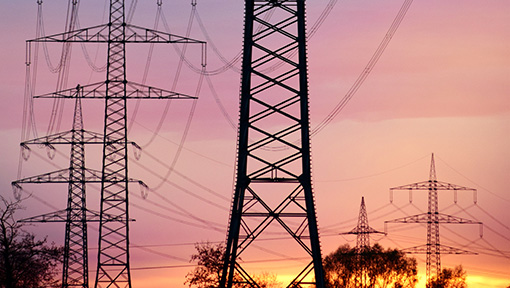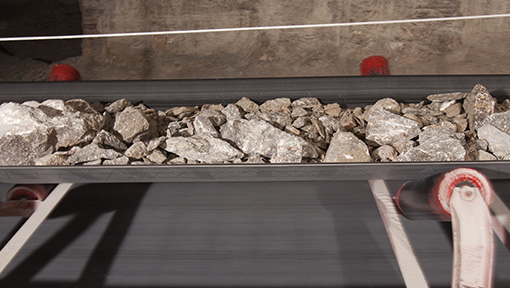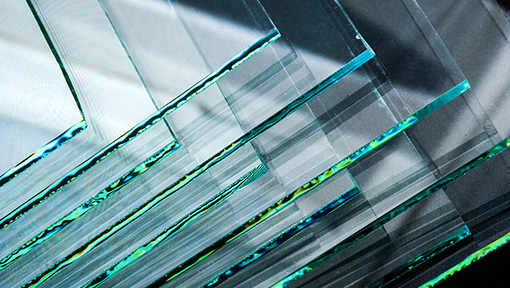- Home
- /
- Business
A Diversified Natural Resource Company
NRP is an asset rich company broken into two business segments, Mineral Rights and Soda Ash. NRP’s Mineral Rights business segment consists of approximately 13 million acres of mineral interests which provide critical inputs for the manufacturing of steel, electricity, and basic building materials, as well as opportunities for carbon sequestration and renewable energy. NRP’s Soda Ash business segment consists of a 49% equity investment in Sisecam Wyoming LLC, one of the world’s lowest-cost producers of soda ash.

Mineral Rights
Natural Resource Partners (NRP) owns approximately 13 million acres of mineral interests and other subsurface rights across the United States. If combined in a single tract, our ownership would cover roughly 20,000 square miles. Our ownership provides critical inputs for the manufacturing of steel, electricity and basic building materials, as well as opportunities for carbon sequestration and renewable energy. If you wish to view our ownership footprint, talk to NRP about leasing opportunities or to see what we have available, please view the interactive map, below:
*NRP does not mine, drill or produce minerals. Instead, we lease our acreage to companies engaged in the extraction of minerals in exchange for the payment of royalties and various other fees. The royalties we receive are generally a percentage of the gross revenue received by our lessees and are typically supported by a floor price and minimum payment obligations that protect us during significant price or demand declines.
Metallurgical

Metallurgical (“Met”) coal is used to fuel blast furnaces that forge steel and is the primary driver of long term cash flows in our Mineral Rights segment. Met coal is a high-quality, cleaner coal that generates exceptionally high temperatures when burned and is an essential element in the steel manufacturing process. Metallurgical coal is a finite and declining resource, particularly in industrialized nations. We believe the indispensable role met coal plays in manufacturing steel combined with the increasing scarcity of the resource will provide support for this portion of our business for decades to come. Our metallurgical coal is located in the Northern, Central and Southern Appalachian regions of the United States.
Thermal

Thermal coal, sometimes referred to as steam coal, is used in the production of electricity. The amount of thermal coal produced in the United States has been steadily falling over the last decade as energy providers shift from coal-fired plants to natural gas-fired facilities, and to a lesser extent, alternative energy sources such as geothermal, wind and solar. We believe the long-term secular decline experienced by thermal coal over the last decade will continue. That fact, combined with the long-term strength of our metallurgical business and the carbon neutral initiatives we discuss below, will result in thermal coal becoming a diminishing contributor to our cash flow in years to come. The vast majority of our thermal sales are located in Illinois and those operations are some of the most cost-efficient mines east of the Mississippi River. The remainder of our thermal coal is located in Montana and Appalachia.
Timber / Oil and Gas / Industrial Minerals / Construction Aggregates

We own timber, oil and gas, industrial minerals and construction aggregates assets across the United States. Our forest assets, located primarily in West Virginia, generate revenues from the forestland through carbon offset credits and timber sales. We engage in active sustainable forest management practices and prudent harvesting techniques to maintain regulatory compliance and preserve future carbon offset opportunities. Our oil and gas mineral assets are predominately located in Louisiana and our various industrial mineral and construction aggregates properties are located across the United States. The industrial minerals and construction aggregates assets include minerals such as limestone, frac sand, lithium, copper, lead and zinc.
Carbon Neutral Initiatives
We continue to identify alternative revenue sources across our large portfolio of land and mineral assets. These types of opportunities include the sequestration of carbon dioxide underground and in standing forests, and the generation of electricity using geothermal, solar and wind energy. As with our existing mineral activities, we do not plan to develop or operate carbon sequestration or carbon neutral energy projects ourselves but lease our acreage to companies that will conduct those operations in exchange for payment of royalties and other fees to us.
Carbon Sequestration

We own the legal rights to sequester carbon dioxide underground in approximately 3.5 million acres located in the southern United States. The carbon capture utilization and storage industry (“CCUS”) is in its infancy and the future is highly uncertain, but a few facts are clear: A sequestration project requires acreage possessing unique geologic characteristics, proximity to sources of industrial-scale greenhouse gas emissions, and the appropriate form of legal title that grants the acreage owner the right to sequester emissions in the subsurface. While carbon sequestration rights and ownership continue to evolve, we believe we own one of the largest collections of acreage with potential for carbon sequestration activities in the United States.
Renewable Energy

We also own the legal rights to generate renewable energy through geothermal energy production in various parts of our asset base across the United States. We believe portions of our asset base possess the geologic characteristics and geographical locations necessary for geothermal energy development as well as solar and wind energy development. With regards to geothermal, the technology to generate safe and reliable “green” electricity using heat found deep underground is advancing rapidly. Once limited to the geologic “hot spots,” new technology has made geothermal energy projects feasible in many places previously thought impossible. With regards to wind and solar energy opportunities, we are actively engaged in discussions for potential use of our acreage for these types of renewable energy developments.
- Metallurgical
-
Metallurgical

Metallurgical (“Met”) coal is used to fuel blast furnaces that forge steel and is the primary driver of long term cash flows in our Mineral Rights segment. Met coal is a high-quality, cleaner coal that generates exceptionally high temperatures when burned and is an essential element in the steel manufacturing process. Metallurgical coal is a finite and declining resource, particularly in industrialized nations. We believe the indispensable role met coal plays in manufacturing steel combined with the increasing scarcity of the resource will provide support for this portion of our business for decades to come. Our metallurgical coal is located in the Northern, Central and Southern Appalachian regions of the United States.
- Thermal
-
Thermal

Thermal coal, sometimes referred to as steam coal, is used in the production of electricity. The amount of thermal coal produced in the United States has been steadily falling over the last decade as energy providers shift from coal-fired plants to natural gas-fired facilities, and to a lesser extent, alternative energy sources such as geothermal, wind and solar. We believe the long-term secular decline experienced by thermal coal over the last decade will continue. That fact, combined with the long-term strength of our metallurgical business and the carbon neutral initiatives we discuss below, will result in thermal coal becoming a diminishing contributor to our cash flow in years to come. The vast majority of our thermal sales are located in Illinois and those operations are some of the most cost-efficient mines east of the Mississippi River. The remainder of our thermal coal is located in Montana and Appalachia.
- Timber / Oil and Gas / Industrial Minerals / Construction Aggregates
-
Timber / Oil and Gas / Industrial Minerals / Construction Aggregates

We own timber, oil and gas, industrial minerals and construction aggregates assets across the United States. Our forest assets, located primarily in West Virginia, generate revenues from the forestland through carbon offset credits and timber sales. We engage in active sustainable forest management practices and prudent harvesting techniques to maintain regulatory compliance and preserve future carbon offset opportunities. Our oil and gas mineral assets are predominately located in Louisiana and our various industrial mineral and construction aggregates properties are located across the United States. The industrial minerals and construction aggregates assets include minerals such as limestone, frac sand, lithium, copper, lead and zinc.
- Carbon Neutral Initiatives
-
Carbon Neutral Initiatives
We continue to identify alternative revenue sources across our large portfolio of land and mineral assets. These types of opportunities include the sequestration of carbon dioxide underground and in standing forests, and the generation of electricity using geothermal, solar and wind energy. As with our existing mineral activities, we do not plan to develop or operate carbon sequestration or carbon neutral energy projects ourselves but lease our acreage to companies that will conduct those operations in exchange for payment of royalties and other fees to us.
Carbon Sequestration

We own the legal rights to sequester carbon dioxide underground in approximately 3.5 million acres located in the southern United States. The carbon capture utilization and storage industry (“CCUS”) is in its infancy and the future is highly uncertain, but a few facts are clear: A sequestration project requires acreage possessing unique geologic characteristics, proximity to sources of industrial-scale greenhouse gas emissions, and the appropriate form of legal title that grants the acreage owner the right to sequester emissions in the subsurface. While carbon sequestration rights and ownership continue to evolve, we believe we own one of the largest collections of acreage with potential for carbon sequestration activities in the United States.
Renewable Energy

We also own the legal rights to generate renewable energy through geothermal energy production in various parts of our asset base across the United States. We believe portions of our asset base possess the geologic characteristics and geographical locations necessary for geothermal energy development as well as solar and wind energy development. With regards to geothermal, the technology to generate safe and reliable “green” electricity using heat found deep underground is advancing rapidly. Once limited to the geologic “hot spots,” new technology has made geothermal energy projects feasible in many places previously thought impossible. With regards to wind and solar energy opportunities, we are actively engaged in discussions for potential use of our acreage for these types of renewable energy developments.
Soda Ash
Natural Resource Partners owns a 49 percent interest in Sisecam Wyoming LLC, the operator of a trona ore mining operation and a soda ash refinery in the Green River Basin of Wyoming. The Green River Basin in Wyoming holds the largest and one of the highest purity known deposits of trona ore in the world.
Sisecam Wyoming is one of the largest and lowest cost producers of natural soda ash in the world. Trona, a naturally occurring soft mineral is processed into soda ash, which is used in a variety of consumer goods, including glass, chemicals, detergents, and other consumer and industrial products.
Soda ash consumption tends to increase in proportion to population and gross domestic product growth rates.
What is Soda Ash?

Soda Ash, or sodium carbonate, has been in use for over 5,000 years. Soda ash occurs in many kinds of mineral waters and in mineral deposits of certain springs and lake brines. The richest and most commonly found source of soda ash is trona, a mix of sodium carbonate, sodium bicarbonate, and water. Although trona can be found in many places, the Green River Basin in Wyoming holds the largest and one of the highest purity known deposits of trona ore in the world. Trona ore is processed into soda ash, which is an essential raw material in flat glass, container glass, detergents, chemicals, paper and other consumer and industrial products.
According to historical production statistics, approximately 30% of global soda ash is produced by processing trona, with the remainder being produced synthetically through chemical processes. The natural production of soda ash from trona is the cheapest way to produce soda ash and consumes less energy and produces fewer undesirable byproducts than synthetic production.
Soda Ash Uses
Soda ash is used in a variety of industries and applications including:

Glass Manufacturing
- Building and Home
- Flat glass – windows/doors
- Mirrors
- Fiberglass insulation
- Internet and fiberoptic cables
- Lightbulbs
- Automotive
- Windshields
- Headlight bulbs
- Fiberglass
- Glassware/Bakeware
- Glasses and Bottles – soda, juice, wine, beer
- Baking dishes and food jars
Baking Goods (e.g. baking soda, yeast, etc.)
Energy and Mining
- Lithium carbonate production
- Flue gas desulfuration
- Drilling fluids
Cleaning Uses
- Washing machine and dishwasher cleaners
- Laundry detergent (liquid and dry)
- Auto detergent
- Dish detergent
Water Treatment
- pH Control
- Municipalities
- Algaecide for ponds and golf courses
Pulp Processing
Specialty Chemicals Manufacturing (e.g. phosphates, chromium, etc.)
Safety

Sisecam Wyoming’s mission is to nurture a culture founded on safety.
Sisecam Wyoming’s stellar safety performance continues to speak for itself. Sisecam Wyoming’s Big Island Mine and Production Facility is a four-time winner of the U.S. Department of Labor Sentinels of Safety award for being the country’s safest underground mine. Sisecam Wyoming’s mine and surface rescue teams are consistently among the best in the country, with seven national mine rescue and three international surface rescue championships.
- What is Soda Ash?
-
What is Soda Ash?

Soda Ash, or sodium carbonate, has been in use for over 5,000 years. Soda ash occurs in many kinds of mineral waters and in mineral deposits of certain springs and lake brines. The richest and most commonly found source of soda ash is trona, a mix of sodium carbonate, sodium bicarbonate, and water. Although trona can be found in many places, the Green River Basin in Wyoming holds the largest and one of the highest purity known deposits of trona ore in the world. Trona ore is processed into soda ash, which is an essential raw material in flat glass, container glass, detergents, chemicals, paper and other consumer and industrial products.
According to historical production statistics, approximately 30% of global soda ash is produced by processing trona, with the remainder being produced synthetically through chemical processes. The natural production of soda ash from trona is the cheapest way to produce soda ash and consumes less energy and produces fewer undesirable byproducts than synthetic production.
- Soda Ash Uses
-
Soda Ash Uses
Soda ash is used in a variety of industries and applications including:

Glass Manufacturing
- Building and Home
- Flat glass – windows/doors
- Mirrors
- Fiberglass insulation
- Internet and fiberoptic cables
- Lightbulbs
- Automotive
- Windshields
- Headlight bulbs
- Fiberglass
- Glassware/Bakeware
- Glasses and Bottles – soda, juice, wine, beer
- Baking dishes and food jars
Baking Goods (e.g. baking soda, yeast, etc.)
Energy and Mining
- Lithium carbonate production
- Flue gas desulfuration
- Drilling fluids
Cleaning Uses
- Washing machine and dishwasher cleaners
- Laundry detergent (liquid and dry)
- Auto detergent
- Dish detergent
Water Treatment
- pH Control
- Municipalities
- Algaecide for ponds and golf courses
Pulp Processing
Specialty Chemicals Manufacturing (e.g. phosphates, chromium, etc.)
- Building and Home
- Safety
-
Safety

Sisecam Wyoming’s mission is to nurture a culture founded on safety.
Sisecam Wyoming’s stellar safety performance continues to speak for itself. Sisecam Wyoming’s Big Island Mine and Production Facility is a four-time winner of the U.S. Department of Labor Sentinels of Safety award for being the country’s safest underground mine. Sisecam Wyoming’s mine and surface rescue teams are consistently among the best in the country, with seven national mine rescue and three international surface rescue championships.
Natural Resource Partners L.P.
Natural Resource Partners L.P. is a diversified natural resource company that owns, manages and leases a diversified portfolio of properties in the United States, including coal, industrial minerals and other natural resources, as well as rights to conduct carbon sequestration and renewable energy activities. In addition, NRP owns an equity investment in Sisecam Wyoming LLC, one of the world’s lowest-cost producers of soda ash.
NRP is headquartered in Houston, TX.

